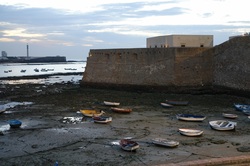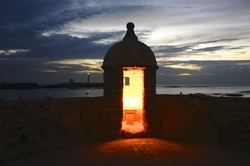
I am a historian and prefer to look for traces of Cádiz’s history in its monuments, but even some of these have been taken over as repositories of modern art. One evening we wandered down to the Playa Caleta and went into the Castle of Santa Catalina. This carefully restored fort, which is built into the ancient sea wall, now houses artists’ workshops and exhibition rooms.
Visiting any new part of Spain is not just about the scenery and its history, we also like to try the local dishes and wine. Naturally Cádiz, being so close to the home of sherry, has plenty of varieties to offer.
A walk round the food market is a great way to see how this part of Andalusia is very different from the Málaga area. There are crabs, almejas that are the size of oysters, tiger prawns, whelks, fresh cod and, of course, tuna. The proximity of the Straits of Gibraltar means that this part of the Atlantic coast is excellent for tuna fishing. I also discovered that every restaurant in the city had tuna on its menu – I never knew you could serve tuna in so many different ways. Sadly I only really like my tuna out of a tin, but I did try some dried tuna and it was delicious – very like Jamón Serrano.
So the question is, where to next year?


Recent Comments